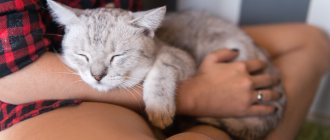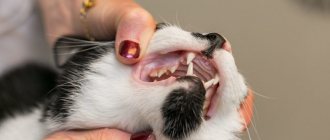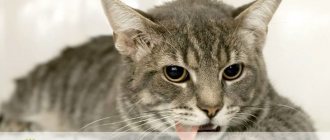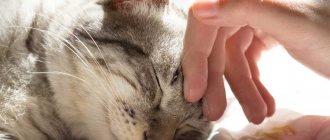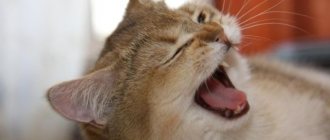When a cat suddenly starts to tremble, it alarms and sometimes even frightens the owners. This phenomenon is called tremor, it is caused by involuntary contraction of one or all muscle groups. There are physiological and pathological reasons for its occurrence, which can only be accurately determined by a veterinary specialist. But in order to provide timely help to the pet, the owner must know the reasons why the cat is trembling.
What is tremor in cats
Tremor in cats is a convulsive contraction of the muscles of the animal’s body, which is visually expressed in the form of small tremors. Sometimes the cat's whole body trembles, but certain parts of it may also shake. Involuntary muscle contraction, called tremor, can also occur in a state of complete rest, indicating maximum relaxation of all muscle groups. However, trembling often indicates that the cat has serious health problems and the animal requires urgent treatment.
Important! If long-haired cats shake with small tremors, then you can only feel it if you put your hand on the animal. But sometimes the tremor is clearly visible and is accompanied by other alarming symptoms.
The cat is trembling in a relaxed state, not sleeping.
Dmitry, Belgorod
December 2, 2018
Male, breed: Siberian, 12 years old, weight 6 kg, neutered. We noticed that the cat was vomiting once a month (there wasn’t a lot of vomit, a mush of food, no hair and a little water), no other ailments were observed, the cat was playful, affectionate, loving, appetite, stool was normal, vomited and went about his business as if nothing had happened. But when this happened again for the fourth time, we took him to the local emergency room (as it turned out later, with a bad reputation, they are trying to do maximum manipulations for a good check), I told the doctor everything, said that we wanted to donate blood for biochemistry and a general analysis, and so do an ultrasound or x-ray. As a result, they intimidated me that I didn’t understand anything, that the cat was dehydrated and in pain, they washed me for 2.5 hours, did an x-ray, some subcutaneous injections, took blood, stuffed Omez and some other pills, tried to put a catheter in one paw , it didn’t work out, they shaved the other paw, put it in it (all this time the cat was actively resisting, screaming, trying to escape and was hysterical), they took him to an IV (Trisol), in general, after all this hell, our cat began to tremble, we turned to others The doctors prescribed us various sedatives: 1. Fospasim; 2.Fitex; 3. Corvalol + Popazol + Piracitam; 4.Novopasit in syrup; 5. Gabapentin, but the cat’s trembling does not go away, and after each stressful moment (blood drawing, for example, or a haircut) it intensifies. I’ll describe the trembling: it’s very similar to chills, but he’s definitely not cold, it’s either small or medium trembling, I don’t understand what it depends on. With minor tremors, the front and hind legs and slightly the back tremble. With moderate tremors, the spasm seems to seize the paws, the entire body and head. It trembles ONLY in a relaxed state, when you are busy with something or sleep, there are no tremors. In the morning and during the day there may be no trembling at all or small trembling, in the evening there is always trembling, just sometimes small, sometimes medium, if you start playing with him at moments of trembling, he switches, plays and does not tremble, if you pick him up and walk around the apartment, he doesn’t either trembles if he just sits in his arms or lies - trembles, does not react painfully or aggressively at these moments, responds to a nickname, if you scratch behind the ear he likes it, sometimes he even purrs mixed with trembling. This trembling has been with us for more than a year and no one can help us (A year ago there was only a slight trembling, about 2 months ago a medium trembling appeared, there is no limit to the worries ((. There are no other complaints, the cat feels great as before, is active, has an appetite and the stool is normal. P.s.: On the x-ray everything is fine, the tests showed increased AST and ALT, they were treated, now they are normal, before the tests I ate PERFECT FIT food in the morning, raw beef in the evening, during treatment with AST and ALT - I was eating Hills LD food for the liver, now they switched to Wahre Liebe for picky (allergic) cats, if this is suddenly important. P.S.S.: Here is a video of the trembling.
The question is closed
Physiological causes of trembling
Sometimes a cat trembles due to external factors such as a sudden change or decrease in the temperature of the surrounding area. Physiological factors of tremor also include stress, sexual arousal, deep sleep or some reflex processes in the animal’s body.
Cold
You will often notice that your cat will shiver after swimming or spending a long time outside on a cold day. This tremor is a mechanism of thermoregulation and does not allow the animal to freeze for a long period of time.
Pampered domestic cats get chills even with a slight drop in ambient temperature, while a pet hardened by frequent walks can stay outside for a long time, even in severe frosts. Owners should take into account such individual characteristics of their cats’ bodies to determine the duration of the walk, since hypothermia easily leads to the development of colds and inflammatory pathologies.
Important! Even if the room is warm, the animal's fur must be thoroughly dried after bathing. It is also important to ensure there are no drafts and not to allow the cat to lie on a cold surface.
Emotional excitement
The cat may tremble as if it were cold when there is strong emotional arousal, positive or negative. Both during fear and during times of great joy, a large amount of certain hormones enter the animal’s bloodstream, which provoke muscle tremors.
By this sign you can determine the mood of your pet. For example, when nervous, a cat shakes as if frozen, arches its back, hisses or meows loudly. Sometimes the readiness to attack is expressed only in the shaking of the tail raised up. At the same time, sitting on the lap of its beloved owner, the animal may tremble slightly and purr with pleasure.
Sexual arousal
During the period of sexual heat, all the senses of male cats become more acute. In the absence of a sexual partner, animals are constantly nervous, strive to get out of the house, and may show aggression or excessive intrusiveness. The cat is shaking from the powerful release of sex hormones into the blood. This condition leads not only to mental disorders of the animal, but also provokes the development of malignant tumors of the reproductive organs and mammary glands. Therefore, the most humane way to get rid of the suffering of cats and female cats that do not take part in breeding is castration.
Other reasons
Some cats may experience tremors as a reflex after eating food. It is especially common to notice how a well-fed kitten trembles in its sleep and does not show signs of anxiety.
Sometimes owners have a question about why the cat trembles when he sleeps. Experts even have a special term “sleepy tremor,” which indicates maximum relaxation of all muscles.
A cat may also shiver in its sleep when sleeping indoors with low air temperatures. This is indicated by the animal’s posture - the cat curls up into a tight ball, “burying” its nose as deeply as possible into the fur or under the paw.
Important! If the cat is shaking in its sleep, trying in vain to warm its frozen limbs, but at the same time the room is quite comfortable and warm, then you should measure the pet’s temperature. Her sharp decline indicates a very serious pathology that is life-threatening.
Poor and restless sleep, which is accompanied by periodic twitching of the limbs and tremors in the body, may be a consequence of stress or prolonged physical exertion. Most often, owners observe this condition in their pet after he “defended his rights” to a female during the period of sexual heat.
“Senile tremor” can also be considered normal. Poor circulation and innervation is the reason why an elderly cat shakes when lying or sitting in a relaxed state.
Treatment method and prognosis
Many pet owners are convinced that if their cat is paralyzed, the only humane way to put it out of its misery is euthanasia. This is only partly true. Indeed, if the condition is serious, then in order not to torment the cat, it is wiser to euthanize it. However, this measure is considered as an extreme measure.
If it is possible to identify the cause that provoked the paralysis, treatment is aimed at eliminating it, and, perhaps, the pet will be cured even without consequences. One or more operations at the veterinary clinic may be required, followed by a long recovery period.
Surgery is required for hernias and some injuries, such as when bone fragments protrude from the wound.
In addition, depending on the etiology of paralysis, the veterinarian prescribes sedatives, non-steroidal anti-inflammatory drugs (Rimadyl, Carprodil, Flexoprofen), anticoagulants (Clopidogrel, Heparin, Aspirin), and antibiotics to relieve pain. If the animal experiences severe pain, the use of opioid drugs (Fentanyl, Hydromorphone) cannot be ruled out.
For inflammatory processes and injuries, steroidal anti-inflammatory drugs are indicated. Metipred, which is administered by drip, has proven itself well. For tick bites, treatment is etiotropic.
Strengthening therapy includes the use of vitamins, in particular group B, which help restore damaged peripheral nerve endings.
If you become dehydrated, you need to replenish lost fluid using a dropper. If the animal has difficulty breathing, oxygen therapy is necessary.
The prognosis for complete or partial paralysis is variable, depending on many reasons - the age and condition of the animal, the degree of damage, etc.
Pathological causes of tremor
The reason why the cat is trembling as if he is cold, although he is at home in comfortable conditions, may be pathological factors. In this case, tremor is often accompanied by the following clinical symptoms:
- photophobia;
- inactivity and lethargy;
- aggression;
- pain syndrome;
- increased body temperature;
- diarrhea or constipation;
- vomit;
- purulent discharge from the nasal cavity or eyes;
- impaired coordination of movements.
Often, the presence of pathology in a cat is indicated by trembling of individual parts of the body or muscle groups, when only the head, front or hind limbs shake.
Important! Tremor must be distinguished from convulsions, which are always accompanied by pain. In kittens up to 5-6 months of age, when their central nervous system is intensively developing, seizures can be physiological in nature. In other cases, seizures indicate the presence of serious disorders of brain function caused by infectious or traumatic factors.
There are many pathological reasons why kittens and adults tremble.
A deficiency of calcium and B vitamins in the body provokes degenerative processes in muscle tissue in cats.
The reason that the kitten is trembling may be infectious rhinotracheitis. In addition to tremor, this disease is accompanied by cough, purulent discharge from the eyes and nose, a significant increase in body temperature and digestive disorders.
With the development of helminthic infestations, when helminths clog the pet's intestines and release a huge amount of toxic products of their vital activity, the kitten experiences symptoms of intoxication, it becomes lethargic and trembles all over its body.
The body's response to the introduction of general anesthesia. If the cat shakes for more than 6 hours after surgery, this may indicate the development of internal bleeding. In this case, urgent medical intervention is necessary.
Body tremors in cats are provoked by acute inflammatory processes in the organs of the genitourinary system and attacks of urolithiasis.
Otitis media, caused by ear mites or other factors, leads to frequent head twitching. The cat scratches the sore ear, hits it, tilts its head towards the affected organ. As a result, scratches and hematomas appear in the ear area. Lack of treatment leads to inflammation spreading to the inner ear and meninges, which provokes death.
During acute liver failure, the cat develops vomiting and diarrhea; at the initial stage, it trembles slightly, and at the stage of failure of the affected organ, it trembles all over.
Head tremor may indicate traumatic brain injury, encephalitis, cerebellar lesions, or drug overdose.
If a kitten walks poorly and his whole body shakes, this may indicate spinal column injuries caused by congenital pathologies, compression or bruises. In adult cats, such symptoms are the result not only of injury, but also the development of tumors or deformation of the intervertebral discs.
If a kitten suddenly becomes lethargic, begins to tremble, first slightly, and then with increasing amplitude, then such tremors and lethargy most often indicate poisoning. If the baby is not taken to the clinic, he will develop seizures and die.
The cause of tremor may be borreliosis, which occurs after a tick bite. The insidiousness of the disease lies in its long latent period, when clinical signs may appear several months after infection.
Tremor combined with lethargy may be one of the signs of toxoplasmosis in cats.
If a kitten walks poorly, shakes, spins in place, or is poorly oriented in space, this may indicate that he has such a serious congenital pathology as hydrocephalus.
Tremors of the limbs, turning into convulsions, can occur in a cat during childbirth or within a week after it. This phenomenon is called eclampsia. It indicates an acute lack of calcium in the animal’s body. If left untreated, your cat will develop seizures, which can be fatal.
Authors: Doctor of Veterinary Sciences Kozlov N.A.
Polyansky R.K.
This article will discuss pathologies in the cervical spine in domestic animals, which cause varying degrees of neurological disorders, often the leading symptom being pain in the neck.
These problems are less common than, for example, surgical diseases of the musculoskeletal system, but they do exist and must be correctly and timely diagnosed and treated professionally. After all, the success of further treatment depends on a quickly established diagnosis. The problem is that most neurological pathologies in the cervical spine have similar clinical signs, and there are quite a lot of such pathologies. Also, in the initial stages, neurological disorders manifest themselves as lameness, which is typical for diseases of the musculoskeletal system. All this prevents the timely provision of assistance to a sick animal.
Etiology. Pathologies of the cervical spine and spinal cord are divided into:
- Degenerative (Wobbler syndrome), damage to the joints of the spine, herniated disc or discopathy;
- Developmental anomalies and genetic predisposition (atlanto-axial instability, syringo-, hydromyelia, atlanto-occipital dysplasia, arachnoid cysts, vertebral deformity, spondylosis deformans;
- Metabolic and feeding disorders (secondary hyperparathyroidism), vitamin A hypervitaminosis in cats;
- Neoplasia (tumors of various nature and localization);
- Idiopathic pathologies;
- Inflammation and infection (discospondylitis, epidural empyema);
- Traumatic (fractures, spondylolisthesis, disc damage, gunshot wounds);
- Toxic (botulism, tetanus);
- Vascular disorders (fibrocartilaginous embolism, hematoma in the spinal canal, necrosis of epidural tissue, myelomalacia).
Clinical signs. They are very diverse and depend on the degree of involvement of nervous structures in the pathological process. The only sign that all these pathologies have in common is the presence of a neurological deficit in the thoracic and pelvic limbs or one of them. In the acute course of the process, the development of tetraplegia and tetraparesis (paresis of all four limbs) is possible. Also, the following signs can most often be observed (one or more of the above symptoms are noted simultaneously):
- the animal is lame on one or both thoracic limbs,
- the animal is constrained, less active,
- holds his head in a forced position - head down,
- impaired coordination of voluntary movement and balance in a standing position (ataxia),
- moves carefully
- A painful reaction is often expressed when examining the animal, usually when the neck is extended.
- owners complain of a changed position of the limb and a change in gait. In this case, the limb(s) are supported on the volar (front surface of the paw) surface.
All these clinical signs should prompt the veterinarian to think about a possible pathology in the cervical spine and conduct additional studies to confirm the diagnosis.
Diagnostics. It is impossible to make an accurate diagnosis of a neurological problem in the cervical spine by collecting only anamnesis and conducting a neurological examination of the animal. After a neurological examination, it is only possible to assume the localization of the process. A very small number of neurological pathologies of the neck can be diagnosed using an x-ray. Therefore, more modern and informative diagnostic methods are required:
- Myelography,
- CT (computed tomography), CT myelography,
- MRI (magnetic resonance imaging).
These diagnostic methods allow you to accurately establish a diagnosis and, depending on the pathology, select the necessary treatment regimen:
- conservative treatment
- surgical intervention.
Wobbler syndrome.
Wobbler syndrome (English: Cervical Vertebral Insability (CVI) or cervical spondylopathy) is a complex of neurological manifestations (shaky gait, weakening of voluntary movements of the limbs, neck bent when walking, etc.) resulting from compression of the spinal cord in the cervical region. Compression occurs when there is instability (instability) or disruption of the structure of the cervical vertebrae, most often the latter.
The word “wobbler” itself is translated from English (['w?bl]) as “to walk staggering; wobble". The incidence of this syndrome is highest in dogs of large breeds : Great Danes, Dobermans, and to some extent in Rottweilers, retrievers, Belgian and German shepherds, wolfhounds and huskies.
MRI of a 5-year-old retriever, Wobbler's syndrome, discopathy at levels C5-C6, C6-C7.
Atlanto-axial instability.
Atlanto-axial instability (syn. atlanto-axial subluxation (subluxation), dislocation (luxation)) - is excessive mobility in the atlanto-axial joint, between the first (C1) and second (C2) cervical vertebrae, which leads to compression of the spinal cord in this area and, as a result, manifests itself in varying degrees of neurological deficit. Atlantoaxial instability is one of the anomalies (malformations) of the spinal column (Sharp NJH, Wheeler SJ 2005). This pathology is typical for dwarf dog breeds (DeLachunta.2009), but it also occurs in large breeds.
Atlanto - axial instability in the York Terrier
Stringo(hydro-)myelia.
Syringo (hydro-) myelia (from the Greek syrinx, genitive case syringos - tube, canal and myelos - spinal cord) is a chronic progressive disease of the nervous system, characterized by the formation of cavities in the spinal cord filled with cerebrospinal fluid, sometimes the proliferation of neuroglia, sensitivity disorders and motor functions, trophic disorders, pain upon touching or flexion/extension of the neck. Sometimes a symptom is increased sensitivity of the skin in the facial area of the skull.
Toy terrier with syringohydromyelmy. Turning the head to the right, pain in the neck.
CT scan of Syringohydromyelia at the C2-C3 level. Hydrocephalus is often observed in such animals at the same time.
Discospondylitis.
Discospondylitis is an infectious disease in which the vertebral bodies and intervertebral discs are involved. The inflammatory process is localized in the intervertebral space and can affect more than 2 vertebral bodies, which is extremely rare in an oncological process, in which, as a rule, only the 1st vertebral body is affected.
MRI of Rottweiler, age – 5 years, discospondylitis – Th 7, Th8.
The cause of discospondylitis in dogs may be a breed predisposition (German and Bernese shepherds), an infectious process (brucellosis, aspergillosis), a foreign body (grass seeds, plant needles and thorns, wood chips) (Fossum TW, 2007), postoperative infection (non-sterile suture material ), as well as the immunosuppressive state of the body.
The cause of discospondylitis in dogs may be a breed predisposition (German and Bernese shepherds), an infectious process (brucellosis, aspergillosis), a foreign body (grass seeds, plant needles and thorns, wood chips) (Fossum TW, 2007), postoperative infection (non-sterile suture material ), as well as the immunosuppressive state of the body.
Discopathies of the cervical spine.
Intervertebral disc herniation is one of the most common neurological diseases (Sotnikov V.V. 2008) in the daily practice of a veterinarian, and at the same time, the most common disease among spinal pathologies in dogs (Jeffery ND, 1995, Sharp and Wheeler, 2005). As a rule, animals aged 2-6 years are affected. Most of them are chondrodystrophic breeds, although there may be exceptions - dachshunds, Pekingese, spaniels. The leading clinical sign is pain in the neck. In such animals, o syndromes (associated with compression of the nerve root) - the thoracic limb lightly touches the floor surface, often only with the tips of the claws.
Injuries.
- Vertebral fractures.
- Spondylolisthesis (from the Greek spondylos - vertebra and olisthesis - sliding) is a disease of the spine, which is manifested by displacement of the vertebra as a result of spondylolysis (congenital non-fusion of the vertebral arch with its body), as well as degenerative changes in the intervertebral disc or as a result of injury.
Fibrous-cartilaginous embolism.
This disease refers to acute ischemia of the spinal cord caused by blockage of arterioles (the smallest arteries) by fibrocartilaginous material (nucleus pulposus of the disc) (Hoerlein BF, 1971). The cause may be injury or “age-related” changes in the intervertebral discs. Symptoms: unilateral or, much less frequently, bilateral paralysis quickly appears, absence of pain in the spinal column (as opposed to a herniated disc), usually followed by a gradual improvement in symptoms without progression of pathology. In general, the pathology is characterized by lateralization of symptoms (either the right or left side is affected). Over time, in most cases, no deterioration is observed. Foreign authors describe cases of FCE with pain syndrome, but such animals, as a rule, died within 2 hours. (Jeffery ND, 1995) This pathology is more common in the cervical spine. It is possible to diagnose the pathology by secondary changes on MRI (phenomena of spinal cord edema in the area of the FCE) and the characteristic clinical picture, but this cannot be established in all cases.
Hematoma in the spinal canal.
A spinal hematoma is a limited accumulation of spilled blood between the membranes of the spinal cord or in it itself, which can lead to its compression.
Hematoma occurs as a result of spinal trauma, an abnormality of a blood vessel (arteriovenous shunt), or bleeding in animals that suffer from bleeding disorders or pathologies of the endocrine system (diabetes).
Literature.
- Denny H. Orthopedics of dogs and cats - M.: Aquarium, 2004
- Sotnikov V.V. Diagnosis and surgical treatment of discopathy of the thoracolumbar spine in dogs. // Abstract of dissertation. candidate of veterinary sciences. M.: 2008.
- deLahunta A, Glass E. Veterinary Neuroanatomy and Clinical Neurology - WB Saunders, 2009
- Jeffery ND Handbook of Small Animal Spinal Surgery, - WB Saunders, 1995
- Fossum TW Small Animal Surgery - Mosby, 2007
- Hoerlein BF Canine neurology. —WB Saunders, 1971
- Sharp NJH, Wheeler SJ Small Animal Spinal Disorders. — Elsevier, 2005.
When to see a doctor
If a cat's tremor is accompanied by fever, indigestion or pain, the animal must be urgently taken to the clinic or a veterinarian called to your home.
Also, a cat whose trembling turns into convulsions or epileptic attacks requires immediate hospitalization.
Sometimes the owner cannot understand why a kitten or an adult cat is shaking violently, and at the same time she arches her back, meows quietly, and tries to burp. Such signs usually indicate ingestion of a foreign object that is causing pain or discomfort. In this case, the animal can only be saved in a clinical setting if the object is surgically removed in a timely manner.
They're trying to dry them out
This is not a unique behavior for cats. We often see this among our peers or even ourselves.
Every time we wash our hands, we sometimes resort to shaking if there are no napkins.
It's the same with cats. If they haven't been well behaved and suddenly get wet in the bath, they can keep their paws dry by shaking them.
© shutterstock
You may not even notice how quickly it happens, but cats may jerk their paws to remove water, causing their paws to become dry.
Diagnostics
You can decide what to do if a kitten or adult cat is trembling only after determining the causes of the tremor. In most cases, it is impossible to do this yourself at home. However, you need to carefully monitor the animal’s behavior in order to answer the following questions for your veterinarian:
- frequency of repetitions and duration of attacks during the day;
- the presence of accompanying symptoms;
- events preceding the onset of tremor;
- dates of the last deworming and vaccination.
It is also necessary to remember whether the cat was bitten by a tick during the year.
To make an accurate diagnosis, the following studies may be prescribed:
- general and clinical blood test;
- Analysis of urine;
- fecal analysis for the presence of helminths;
- radiography of the head, spine, chest and abdominal cavity;
- MRI or CT scan of the brain;
- myelography – to detect spinal tumors and intervertebral disc pathologies;
- electromyography.
A cerebrospinal fluid tap may be taken to confirm encephalitis.
Causes of the disease
There are a lot of factors that cause restriction or lack of functioning of a certain organ, so it is impossible to make a diagnosis based only on external signs.
Reasons that can cause paralysis include the following:
- spinal injuries with damage, rupture, contusion of the spinal cord (being hit by the wheels of a car, falling from a height, etc.);
- inflammatory processes of the spinal cord that developed against the background of poisoning and infections;
- bites of parasites that secrete toxins;
- poisoning with toxic substances;
- displacement and infringement of intervertebral discs;
- fat or fibrocartilaginous embolism;
- cardiovascular pathologies;
- rabies and other deadly viral infections.
Paralysis in a cat can be complete or partial, affecting both hind legs (paraplegia) or one side, for example, the left hind and front legs (hemiplegia), all four limbs (tetraplegia), etc. In addition, there is a gradation according to the area of damage - paralysis of the facial nerve, larynx, spinal, injury to the radial nerve.

